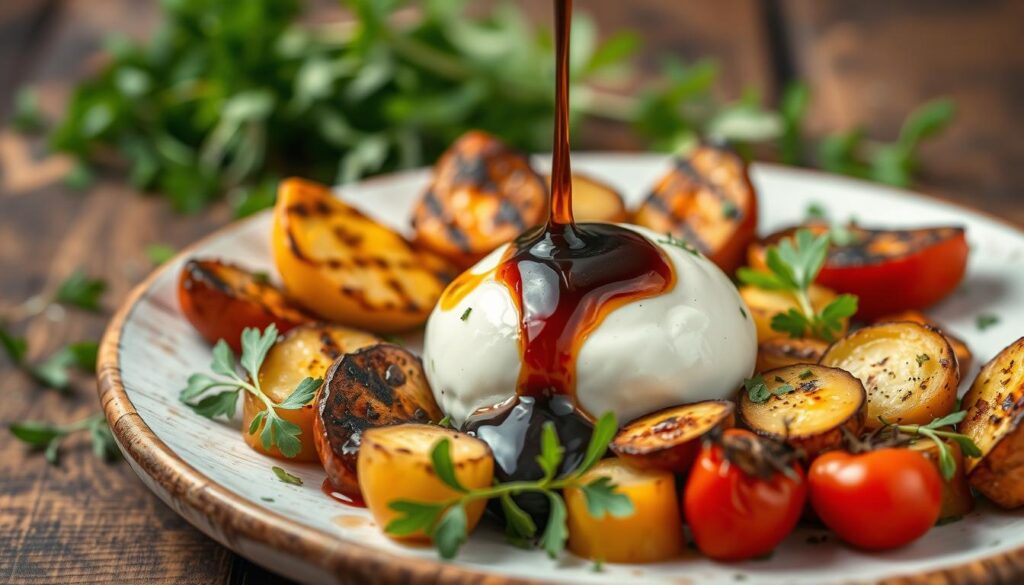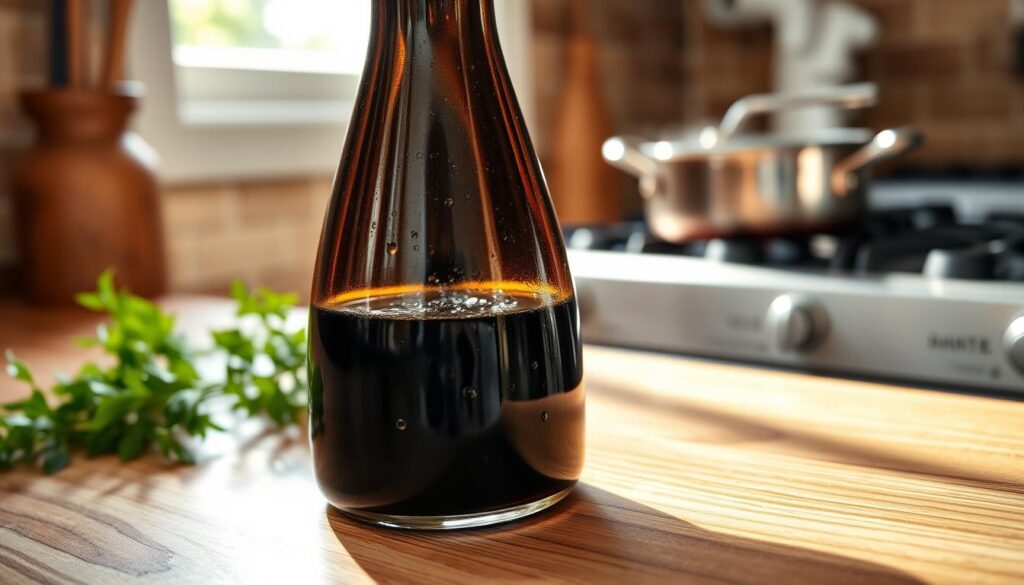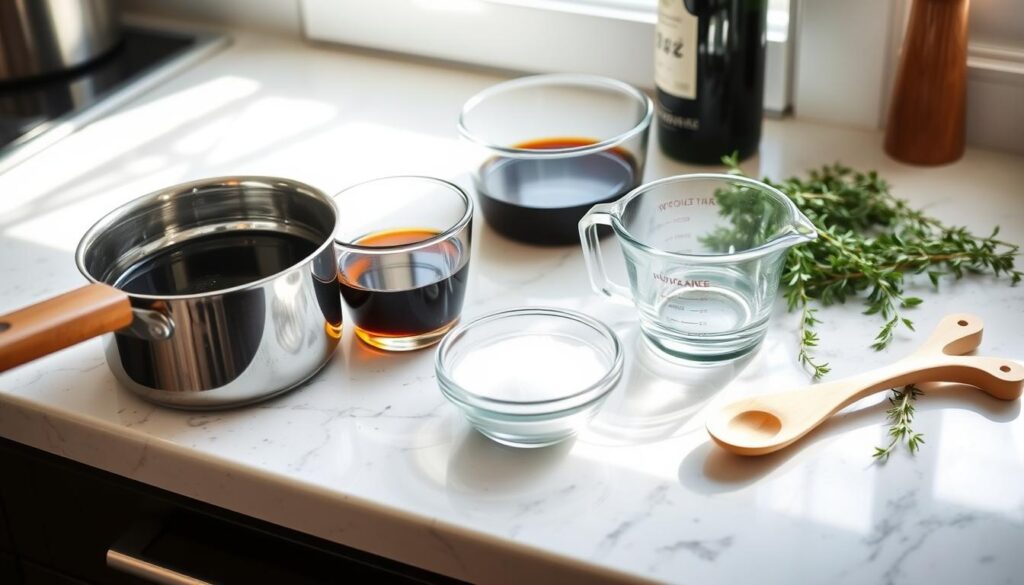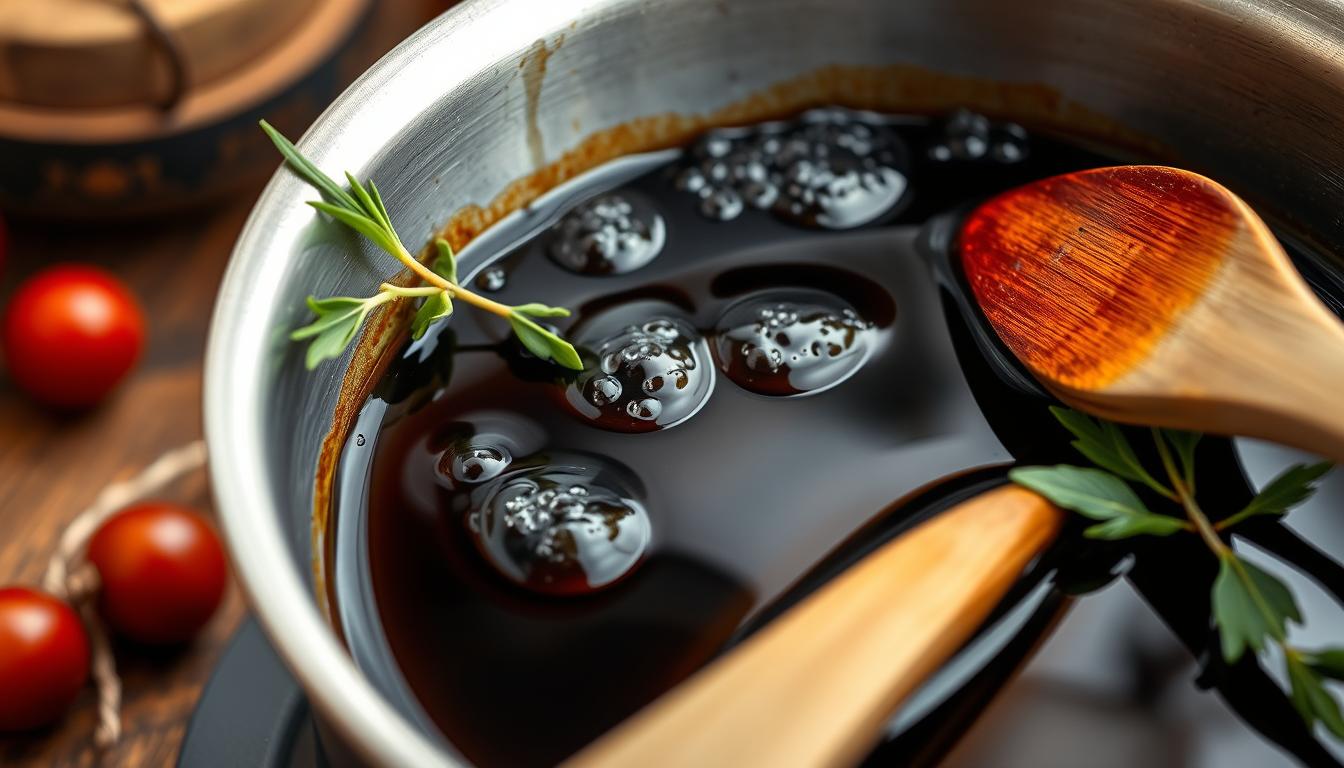The smell of balsamic reduction cooking reminds me of my grandmother’s kitchen. She used it to make any dish special. Now, I’m happy to share this secret with you. Making your own balsamic reduction is easy and will change your cooking.
Balsamic reduction comes from Italy and is loved everywhere. It’s great on salads or with grilled meats. This balsamic vinegar glaze will make your meals better.
In this guide, we’ll show you how to make perfect balsamic reduction. You’ll learn to make this fancy condiment at home. It will impress your guests and make your dishes more special.
Table of Contents
Understanding Balsamic Reduction: A Gourmet Essential
Balsamic reduction is a thick, syrupy version of balsamic vinegar. It’s made by simmering down the vinegar until it’s very concentrated. This Italian condiment adds a rich flavor and a glossy look to dishes. Let’s dive into what makes balsamic syrup unique and its role in today’s cooking.

What Makes Balsamic Reduction Special
Balsamic reduction has a deep, intense flavor. As it cooks down, its sugars become sweeter, creating a complex taste. Its thick texture beautifully coats food, enhancing both taste and appearance.
Common Uses in Modern Cuisine
This versatile Italian condiment is used in many ways:
- Drizzled over fresh fruits or aged cheeses
- Used as a glaze for grilled meats or roasted vegetables
- Added to vinaigrettes for salads
- Incorporated into desserts like ice cream or strawberries
Difference Between Regular Balsamic and Reduction
While both come from grape must, balsamic syrup is thicker and sweeter. Regular balsamic vinegar is thinner and less sweet. The reduction process makes the flavors stronger, so it’s used in small amounts for big flavor.
| Characteristic | Regular Balsamic | Balsamic Reduction |
|---|---|---|
| Consistency | Thin, liquid | Thick, syrupy |
| Flavor Intensity | Mild to moderate | Strong, concentrated |
| Sweetness | Less sweet | Sweeter |
| Usage Amount | More liberal | Used sparingly |
Essential Ingredients for the Perfect Balsamic Reduction
Creating a savory reduction starts with choosing the right ingredients. The star of the show is balsamic vinegar. Pick a high-quality bottle for the best flavor. Aged balsamic vinegar offers a richer taste, but younger varieties work too.

To enhance your reduction, consider these optional additions:
- 1-2 tablespoons of honey or brown sugar for sweetness
- A pinch of salt to balance flavors
- Fresh herbs like rosemary or thyme for aromatics
The quality of your balsamic vinegar affects, of course, the final product. A good vinegar reduces to a syrupy consistency with a perfect balance of sweet and tangy notes. Lower quality vinegars might need added sweeteners to achieve the desired taste.
Honey or sugar not only adds sweetness but helps thicken the reduction. This is especially useful if you’re using a younger balsamic vinegar. Salt enhances the overall flavor profile, while herbs infuse subtle aromatic notes into your savory reduction.
Remember, the ingredients you choose will shape the taste of your balsamic reduction. Try different combinations to find the blend that works best for you.
Kitchen Tools and Equipment Needed
To make a perfect balsamic drizzle or sauce, you need the right tools. Let’s look at the essential equipment for this tasty reduction.
Required Cookware
A heavy-bottomed saucepan is key for even heat when reducing balsamic vinegar. Pick a pan that holds at least 2 quarts to avoid spills. A long-handled wooden spoon or silicone spatula is perfect for stirring.

Optional but Helpful Tools
A candy thermometer is useful for checking your sauce’s temperature. Aim for 215°F (102°C) for the best consistency. Silicone brushes are great for drizzling your reduction. A fine-mesh strainer can make your drizzle smoother by removing impurities.
Storage Containers
After your reduction is ready, store it in airtight glass bottles or jars. These keep the flavor fresh and prevent contamination. Squeeze bottles are handy for drizzling your sauce over salads or desserts.
| Essential Tools | Optional Tools | Storage Options |
|---|---|---|
| Heavy-bottomed saucepan | Candy thermometer | Glass bottles |
| Wooden spoon or silicone spatula | Silicone brush | Airtight jars |
| Measuring cups | Fine-mesh strainer | Squeeze bottles |
Balsamic Reduction Recipe: Step-by-Step Guide
Making a balsamic reduction is easy and rewarding. This guide will help you make a perfect balsamic topping every time.
Preparation Steps
First, pick high-quality balsamic vinegar. Pour 2 cups into a non-reactive saucepan. Add 1/4 cup of honey or brown sugar for sweetness.
Cooking Process
Put the saucepan on medium heat. Let it simmer gently, stirring now and then. Then, lower the heat to low and cook uncovered. It takes about 15-20 minutes to finish.
Testing for Doneness
Your balsamic topping is done when it sticks to the back of a spoon. It should have reduced to about 1/3 of its original amount. It will thicken more as it cools.
| Original Volume | Reduced Volume | Consistency |
|---|---|---|
| 2 cups | 2/3 cup | Syrupy |
After it’s done, take it off the heat and let it cool. Store your homemade balsamic reduction in an airtight container. Use it to make salads, meats, or desserts taste richer with its complex flavor.
Tips for Achieving the Perfect Consistency
Making the perfect balsamic syrup needs focus and patience. It’s all about finding the right mix of thickness and taste. Watch closely as your reduction cooks.
Stir your balsamic reduction often to avoid burning. It should glide smoothly off the back of a spoon. If it’s too thin, cook it longer. If too thick, add a bit of water and warm it up.
Keeping the temperature low is key. A steady simmer is best. High heat can make the syrup bitter and uneven.
Here are some tips for the perfect consistency:
- Starting volume of vinegar
- Desired end volume
- Cooking temperature
- Pan size and material
| Starting Volume | Cooking Time | End Volume |
|---|---|---|
| 2 cups | 15-20 minutes | 1/2 cup |
| 4 cups | 25-30 minutes | 1 cup |
| 8 cups | 35-40 minutes | 2 cups |
Remember, your reduction will thicken as it cools. Stop cooking when it’s a bit thinner than you want. With practice, you’ll get it right every time.
Storage and Shelf Life Guidelines
Proper storage of your homemade balsamic sauce keeps it fresh for a long time. This Italian condiment, stored right, can add flavor to your meals for weeks or months.
Proper Storage Methods
Keep your balsamic reduction in an airtight glass container. Glass keeps out unwanted flavors. Store it in a cool, dark spot like your pantry or fridge. Refrigeration can make your balsamic sauce last up to three months.
Signs of Spoilage
Watch for color, smell, or texture changes in your balsamic reduction. If you see mold, bad smells, or a weird texture, throw it away. Good balsamic sauce stays dark and syrupy.
Reheating Instructions
To reheat your balsamic sauce, warm it in a small saucepan over low heat. Stir gently until it’s warm enough. If it’s too thick, add a bit of water or vinegar while it’s heating.
| Storage Method | Shelf Life | Best Practices |
|---|---|---|
| Room Temperature | 1-2 weeks | Keep in a cool, dark place |
| Refrigerated | 2-3 months | Use airtight glass container |
| Frozen | Up to 6 months | Thaw in refrigerator before use |
Creative Ways to Use Your Balsamic Reduction
Balsamic reduction is a versatile ingredient that can enhance a variey of dishes. It adds depth and sophistication to your culinary creations. You can use it in salads, meats, and even desserts.
Salad Enhancements
Transform your salads with a drizzle of balsamic reduction. Mix it with olive oil, Dijon mustard, and honey to make a tangy dressing. Toss it with fresh greens, berries, and crumbled goat cheese for a gourmet touch.
Meat and Fish Pairings
Use balsamic reduction as a glaze or marinade for meats and fish. Brush it on grilled chicken, pork chops, or salmon during the last few minutes of cooking. For a delicious balsamic marinade, combine the reduction with garlic, rosemary, and olive oil before coating your protein of choice.
Dessert Applications
Surprise your taste buds by incorporating balsamic reduction into desserts. Drizzle it over fresh strawberries, vanilla ice cream, or chocolate cake. The sweet-tart flavor complements rich, creamy desserts beautifully.
| Dish | Balsamic Reduction Use | Flavor Profile |
|---|---|---|
| Caprese Salad | Drizzle over tomatoes and mozzarella | Sweet and tangy |
| Grilled Steak | Brush on as a glaze | Rich and savory |
| Roasted Vegetables | Toss with reduction before roasting | Caramelized and complex |
| Fruit Tart | Drizzle over fresh berries | Sweet and tart contrast |
Troubleshooting Common Issues
Making a perfect balsamic vinegar glaze can be tricky. Let’s tackle some common problems you might face when creating your balsamic topping.
Burning is a frequent issue. To avoid this, use low heat and stir often. If your balsamic topping starts to smoke, remove it from heat immediately and transfer to a cool pan.
Crystallization happens when sugar in the balsamic vinegar glaze forms crystals. Prevent this by adding a splash of water and reheating gently. Stir until crystals dissolve.
If your reduction is too thick, thin it out with a little water or extra vinegar. For a too-thin glaze, continue cooking until it reaches your desired consistency.
| Issue | Cause | Solution |
|---|---|---|
| Burning | High heat | Use low heat, stir often |
| Crystallization | Sugar buildup | Add water, reheat gently |
| Too thick | Overcooked | Add water or vinegar |
| Too thin | Undercooked | Continue cooking |
Remember, practice makes perfect. With these tips, you’ll soon master the art of creating a delicious balsamic vinegar glaze for all your culinary creations.
Conclusion
Learning to make balsamic reduction is a big step up for your kitchen. It adds a fancy touch to many dishes. Just a few steps can turn a simple sauce into a rich, flavorful one.
This recipe is easy to follow and makes a great sauce. By reducing balsamic vinegar, you open up new cooking possibilities. It adds depth and complexity to your dishes.
Why not try making your own balsamic reduction? It can change how you cook. Use it on roasted veggies or grilled meats. It’s your secret ingredient for amazing dishes at home.

